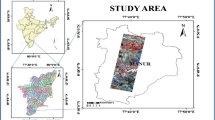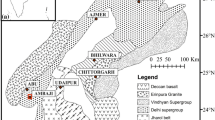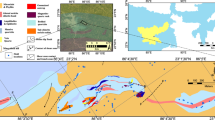Abstract
Hyperspectral remote sensing consolidates imaging and spectroscopy in a solitary system which frequently comprises big datasets and necessitates the novel processing methods. In the present study, Cheranmadevi Block of Tirunelveli District in Tamil Nadu is selected to extract the abundant limestone mineral. Hyperion is one of the freely available hyperspectral imagery containing 242 spectral bands with 10-nm intervals in the wavelength between 400 and 2500 nm. The main objectives of the present research work are to enhance the imagery visualization, end member extraction, and classification, and estimate the abundant limestone quantity by removing the striping error in Hyperion imagery. The scanning electron microscope with energy-dispersive X-ray spectroscopy analysis is performed to identify the chemical composition of limestone mineral. The spectral reflectance of limestone is characterized using analytical spectral devices like a field spectroradiometer. Limestone has deep absorption in the short-wave infrared region (1900–2500 nm) around 2320–2340 nm due to their calcite composition (CaCO3). The feature extraction in Hyperion data is performed using various preprocessing steps like bad bands removal, vertical strip removal, and radiance and reflectance creation. To improve the classification accuracy, vertical strip removal process is performed using a local destriping algorithm. The absolute reflectance is achieved by the atmospheric correction module using Fast Line-of-sight Atmospheric Analysis of Hypercubes. The acquired reflectance image spectra are compared with the spectral libraries of USGS, JPL, and field spectra. Destriping enhances qualities of Hyperion data interims of the spectral profile, radiance, reflectance, and data reduction methods. The present research work focused on the local destriping algorithm to increase the quality and quantity of limestone deposit extraction.



















Similar content being viewed by others
References
Adam E, Mutanga O, Rugege D (2010) Multispectral and hyperspectral remote sensing for identification and mapping of wetland vegetation: a review. Wetl Ecol Manag 18(3):281–296
Balachandran A (2009) Technical report series: district groundwater brochure. Government of India, Ministry of Water Resources, Central Ground Water Board, South Eastern Coastal Region, Chennai, pp 1–20
Ballanti L, Blesius L, Hines E, Kruse B (2016) Tree species classification using hyperspectral imagery: a comparison of two classifiers. Remote Sens 8(6):445
Beiranv A, Hashim M (2011) The Earth Observing-1 (EO-1) satellite data for geological mapping, southeastern segment of the Central Iranian Volcanic Belt, Iran. International Journal of Physical Sciences 6(33):7638–7650
Chuan Z, Fawang Y, Haixia H, Hongcheng L (2014) Study on the forest vegetation restoration monitoring using HJ-1A hyperspectral data. In IOP Conference Series: Earth and Environmental Science 17(1):012082
Ciampalini A, Consoloni I, Salvatici T, Di Traglia F, Fidolini F, Sarti G, Moretti S (2015) Characterization of coastal environment by means of hyper- and multispectral techniques. Appl Geogr 57:120–132
Dave PN, Bhandari J (2013) Prosopis juliflora: a review. International Journal of Chemical Studies 1(3):181
El-Magd IA, El Kafrawy S, Farag I (2014) Detecting oil spill contamination using airborne hyperspectral data in the River Nile, Egypt. Open Journal of Marine Science 4(2):140–150
Gong P, Pu R, Biging GS, Larrieu MR (2003) Estimation of forest leaf area index using vegetation indices derived from Hyperion hyperspectral data. IEEE Transactions Geoscience Remote Sensing Letters 41(6):1355–1362
Hoshino B, Aramalla AK, Lbasit MAMABDE et al (2012) Evaluating the invasion strategic of mesquite (Prosopis juliflora) in eastern Sudan using remotely sensed technique. Journal of Arid Land Studies 4:1–4
Kruse FA (2003) Mineral mapping with AVIRIS and EO-1 Hyperion in: Presented at the 12th JPL Airborne Geoscience Workshop, 24–28 February, 2003. Pasadena, California
Kruse FA, Boardman JW (2000) Characterization and mapping of kimberlites and related diatremes using hyperspectral remote sensing. In Aerospace Conference Proceedings, 2000 IEEE vol 3, pp 299–304. IEEE
Kruse FA, Perry SL (2007) Regional mineral mapping by extending hyperspectral signatures using multispectral data. In Aerospace Conference, 2007 IEEE, pp 1–14. IEEE
Kruse FA, Boardman JW, Huntington JF (2003) Comparison of airborne hyperspectral data and EO-1 Hyperion for mineral mapping. IEEE Transactions Geoscience Remote Sensing Letters 41(6):1388–1400
Kruse FA, Perry SL, Caballero A (2006) District-level mineral survey using airborne hyperspectral data, Los Menucos, Argentina. Ann Geophys 49(1):83–92
Kruse FA, Bedell RL, Taranik JV, Peppin WA, Weatherbee O, Calvin WM (2012) Mapping alteration minerals at prospect, outcrop and drill core scales using imaging spectrometry. Int J Remote Sens 33(6):1780–1798
Kumar MV, Yarrakula K (2017) Comparison of efficient techniques of hyper-spectral image preprocessing for mineralogy and vegetation studies. Indian Journal of Geomarine Science 46:1008–1021
Minu S, Shetty A (2015) Atmospheric correction algorithms for hyperspectral imageries: a review. International Research Journal of Earth Sciences 3(5):14–18
Mureriwa N, Adam E, Sahu A, Tesfamichael S (2016) Examining the spectral separability of Prosopis glandulosa from co-existent species using field spectral measurement and guided regularized random Forest. Remote Sens 8(2):144
Pal MK, Porwal A (2015) Destriping of Hyperion images using low-pass-filter and local-brightness-normalization. In Geoscience and Remote Sensing Symposium (IGARSS), 2015 IEEE International pp 3509–3512
Pour AB, Hashim M (2014) ASTER, ALI and Hyperion sensors data for lithological mapping and ore minerals exploration. Springerplus 3(1):130
Pour AB, Hashim M (2015) Evaluation of earth observing-1 (EO1) data for lithological and hydrothermal alteration mapping: a case study from Urumieh-Dokhtar volcanic belt, SE Iran. Journal of the Indian Society of Remote Sensing 43(3):583–597
Pour AB, Hashim M, van Genderen J (2013) Detection of hydrothermal alteration zones in a tropical region using satellite remote sensing data: Bau goldfield, Sarawak, Malaysia. Ore Geol Rev 54:181–196
Qingwei Z, Weisheng M, Chang L, Moquan S, Aihua W, Donglu J, District H, Beijing PRC (2013) Research on improved destriping algorithm with spectral moment matching for hyper-spectral images. Asian Association of Remote Sensing :1–5
Smara (2015) Oblique striping removal in EO-1 hyperspectral remote sensing imagery. International Symposium on Advances on Remote Sensing Technologies and Computation RESENS 2015, At Barcelona Spain
Smith R (2013) Analyzing hyperspectral images. TIN Maps, pp 1–40
Vignesh M, Yarakkula K (2016) Identification of the alluvial soil deposit using hyperspectral imagery. Geospatial Technologies for Rural Development, pp 148–152
Vigneshkumar M, Yarakkula K (2017) Nontronite mineral identification in nilgiri hills of Tamil Nadu using hyperspectral remote sensing. IOP Conference Series: Materials Science and Engineering 263(3):032001
Vigneshkumar M, Yarrakula K (2017) Spatial distribution of Prosopis juliflora using the fusion of hyperspectral and Landsat-8 OLI imagery. Indian Journal of Ecology 44:548–554
Wu C, Niu Z, Tang Q, Huang W (2008) Estimating chlorophyll content from hyperspectral vegetation indices: modeling and validation. Agric For Meteorol 148(8):1230–1241
Zaini N, van der Meer F, van der Werff H (2014) Determination of carbonate rock chemistry using laboratory-based hyperspectral imagery. Remote Sens 6(5):4149–4172
Zigovecki Gobac Z, Posilovic H, Bermanec V (2009) Identification of biogenetic calcite and aragonite using SEM. Geologia Croatica 62(3):201–206
Author information
Authors and Affiliations
Corresponding author
Rights and permissions
About this article
Cite this article
Kumar, V., Yarrakula, K. Enhancement of limestone mineral identification using Hyperion imagery: a case study from Tirunelveli District, Tamil Nadu, South India. Arab J Geosci 12, 38 (2019). https://doi.org/10.1007/s12517-018-4149-3
Received:
Accepted:
Published:
DOI: https://doi.org/10.1007/s12517-018-4149-3




